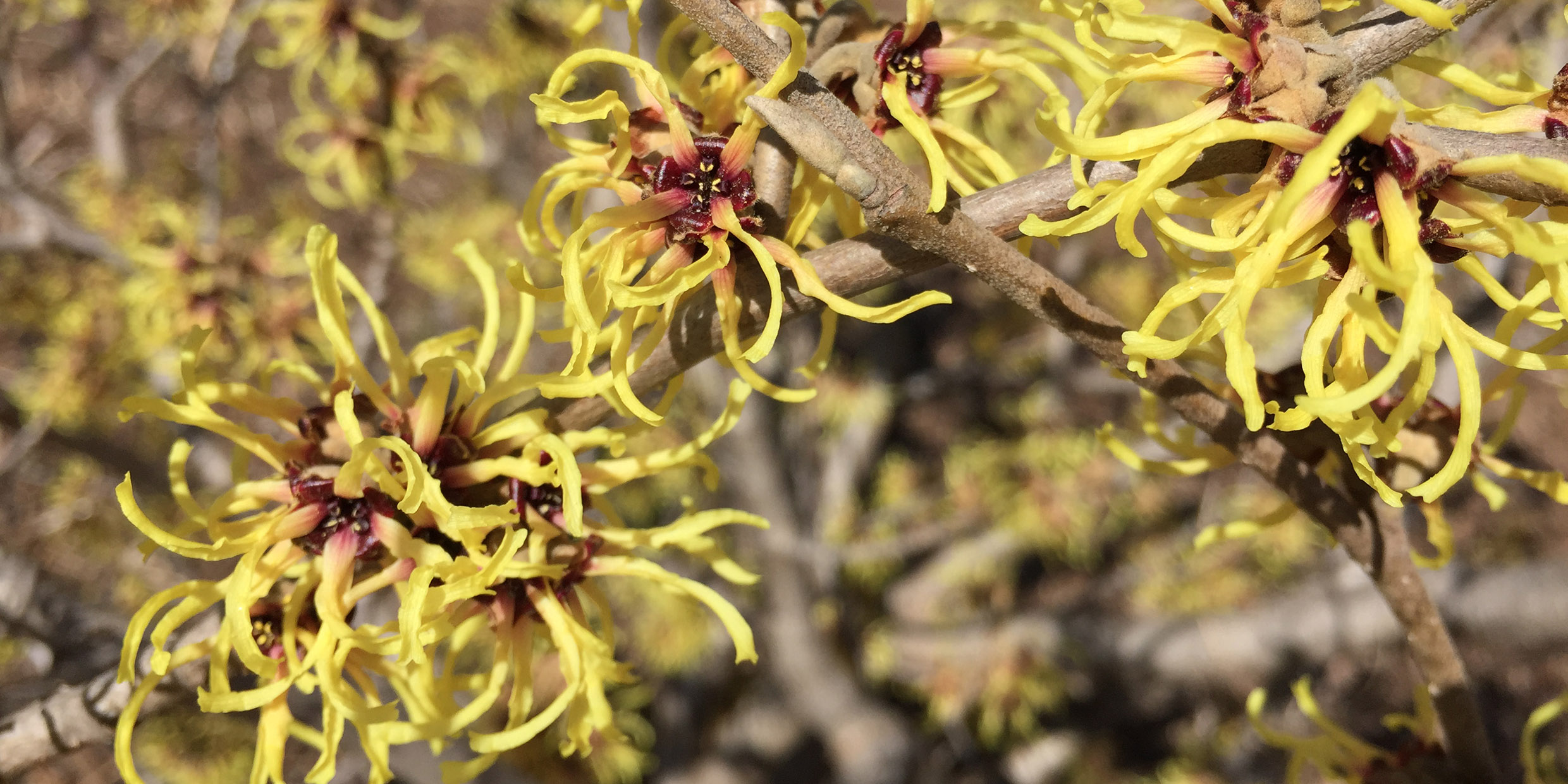Originally published 28 November 1988
While walking with several students on my college campus I saw at the woods’ edge a spray of gold against a grey November sky. It was the witch hazel, that most untypical tree, bursting riotously into bloom when everything else is closing down.
I drew the attention of the students to the golden tree with the peculiar habit, but they did not share my enthusiasm. And why should they? They are young, in the endless summer of their lives. The witch hazel, intemperately thumbing its nose at impending winter, is a tree for the middle-aged.
None of my botanical handbooks explain why the witch hazel blooms in October and November, even as its leaves are falling to the ground. Where are the insects that will pollinate the blossoms? Donald Stokes, who has written a wonderful book on wild shrubs and vines, tells of watching witch hazel in bloom and seeing no visitors but ants. New England naturalist Jorie Hunken guesses that late-appearing flies may be the pollinators. Perhaps the witch hazel is nature’s all-night cafe, where the few insects of early winter can find a bite to eat when the regular establishments are closed. The tree has these late-season customers all to itself.
In any other season witch hazel would be inconspicuous. The “witch” in the tree’s name probably derives from the Old English “wych,” meaning “weak.” The tree is not much more than a sprawling shrub and its blossoms are unkempt tangles of scraggly ribbons. But in spare November even this anemic display of color is welcome. Stubbornly out of step with the seasons, the witch hazel is a touch of spring in autumn, a touch of birth in death. Thoreau, with customary transcendence, called the witch hazel thicket “a faery place…a part of the immortality of the soul.”
An explosion of seeds
The springlike blossoms are not the only trick by which the tree enlivens November. There’s also the energetic way it spreads its seeds. The seeds do not quickly follow the blossoms, as with more typical trees. Instead, the witch hazel hoards its seeds for a full 12 months in urn-like capsules. Then, in late October or early November, as the leaves fall and blossoms are appearing, last year’s capsules open, exposing ripe seeds, one or two to a pod. With an audible snap, the pod explodes the seeds into the air. People who measure such things say that the seeds can be propelled as far as 20 feet from the tree. Afterwards, the open-mouthed capsules gape like tiny gargoyles among the yellow blossoms.
The English “witch hazel” is an elm. Supple branches of the English tree have long been used for divining, or dowsing, by water witches. The American witch hazel is credited with the same water-finding properties as its English namesake. The dowser breaks a forked branch from the tree and strips it bare. The stick is supposed to dip over underground reservoirs of water.
The use of sticks or rods for divination goes back at least to the Greeks and Egyptians. In the Middle Ages forked twigs were used in Europe to discover underground veins of minerals. By the 16th century divining rods were widely used in England for finding hidden springs, and not long afterwards the scientific debate began about whether the dowser’s apparent skill was due to sorcery, chance, or a real physical effect. Over the years there have been innumerable scientific investigations of dowsing. The consensus among 20th century scientists is that the art of using sticks to find water has no basis in known laws of nature.
The champions of dowsing are utterly convinced the effect is real. Most scientists would ascribe the dowser’s occasional success to luck or common sense. Certainly the twig has nothing to do with it. Dowsers have been consistently unsuccessful in the kind of controlled tests that would convince a scientific skeptic.
Long used in folk medicine
But even confirmed skeptics will admit that the Halloween-blooming witch hazel is a bewitching tree. Its sorcery certainly cheered my spirits when I saw that wonderful yellow thicket at the edge of the November woods. The late-blooming magic may have something to do with the tree’s attractiveness to dowsers, and might also explain its long use in folk medicine.
North American Indians used the plant to make a poultice for swellings and tumors. In my grandmother’s day, an extract of witch hazel was applied to scraped knees and insect bites. You can still buy “Witch Hazel” at the drug store, but as far as I know chemists have not found any real medicinal properties to the plant, aside from a certain astringency due to tannin in the bark. The curative properties probably have more to do with the alcohol content of the commercial mixture than with any extract of the plant.
According to manuals of herbal medicine, decoctions, teas, and salves of witch hazel are good for loose skin, tired eyes, varicose veins, and piles. It’s not surprising that folk wisdom credits the late-blooming witch hazel with cures for the maladies of middle age. Any tree that puts on such a springlike show in November deserves the admiration of all of us who have entered the autumn of our lives.




These musings are so … healing. I’m transported out of the office and — for a moment — sitting on a rock with Chet, looking at a witch hazel in bloom.